
The five-day festival also included performances, film screenings and talks all around the city. We also took part in it, with an evening conversation with artist Ulrike Theusner at 100 Gramm Bar & Lounge. If you didn’t have the time to see it all, there is no need to worry. Many shows are still open, and we created a selection for you of the exhibitions not to miss.
Eigen+Art opened for Berlin Art Week an exhibition with the brilliant German artist Ulrike Theusner. Her new show, titled The Passengers of the Night, lends its name from the homonymous movie, and discusses the variety of human struggles in the most poetic way. Her practice is based on drawings, and addresses it with a powerful contrast between the color she uses and the dark vibes that they convey. Her sketches are filled with obscure figures, as a way to deal with the death surrounding us and waiting for us. Yet there is a coefficient of lightness and fun, and also a suggestion for a possible way out.
The exhibition opens with the stunning drawing of a cave, as a place of comfort and solace, where we can reconnect with ourselves. In a world filled with inputs, injustices and absorbed by technology, the connection to our inner selves and to analog means seems to be fundamental. Art itself is for Theusner a way out, and a powerful instrument to deal with all the troubling things surrounding us, to find meaning, and as she said in our interview: “That's why for me it's essential to do it, because if I could not do it, it would be all inside and wouldn’t come out and I would kind of freak out.”
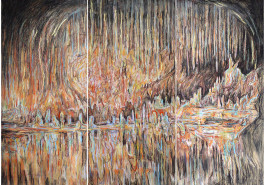
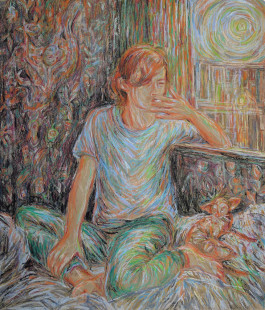
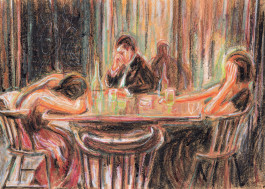
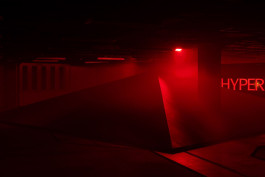
LAS Art Foundation inaugurated a powerful installation by Christelle Oyiri, presented for the first time in Berlin, titled Dead God Flow. The foundation always chooses different locations in the city for their exhibition, and this time it was the turn of CANK in Neukölln. The space is a former department store, iconic in its stripped past glory, and is immersed in darkness, rhythmically brightened by the neon lights of Oyiri's installation.
The artist works with various media, from music, to video and installation, and the exhibition is made up of all of them. Screened in this enthralling environment are two of her video works, Hauntology of an OG and HYPERFATE. Hauntology of an OG connects the American city of Memphis to the origin of its name in ancient Egypt, but also to the recent history of the city, which was unfortunately the place where Martin Luther King was murdered.
HYPERFATE on the other hand explores the mythologisation of rappers in American and French cultures, and analyzes the different sides of their sanctification. Her work is deeply moving, and the installation involves all our senses. As the artist stated: “Dead God flow reimagines the exhibition space as a coded séance, a choreography of image, sound and presence where the past and future refuse to separate”.
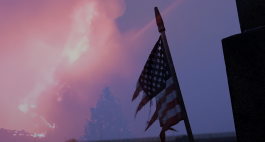
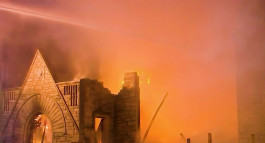
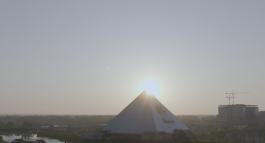
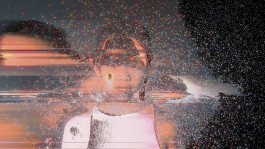
Charmaine Poh was named by Deutsche Bank artist of the year for 2025. The Singaporean- Chinese artist was thus presented for Berlin Art Week with her first institutional solo exhibition at Palais Populaire, titled Make a travel deep of your inside, and don’t forget me to take. The focus of her practice – which spans from video to installation and performance – is an investigation on identity, power structures, feminism and queerness in Southeast Asia.
The exhibition comprehends different pieces, addressing the variety of themes that are dear to the artist. As Britta Färber, the curator of the exhibition stated: “Her gentle, vulnerable, yet persistent works send a strong message against the harshness with which the exclusion of minorities and the socially disadvantaged is increasingly ignored and marginalized today”.
Her compelling work What’s softest in the world rushes and runs over what’s hardest in the world addresses the feelings of various LGBTQ+ parents, and tells their touching journeys into parenthood. Another video work, The Moon is Wet, created for the occasion of this exhibition, investigates the different facets of Singapore, from its financial role to its nature, while giving space to the forgotten stories and marginalized voices of domestic workers. Her work also addresses the traumatic experience she had as a child television star in the 1990s, and addresses the impact of early sexualization and media attention at a young age. Both delicate and powerful, her voice is an outstanding example of the insight of a generation of artists on the issues of contemporary times.
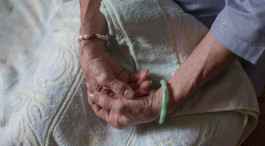
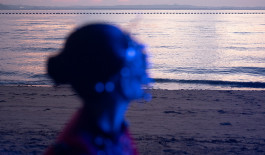
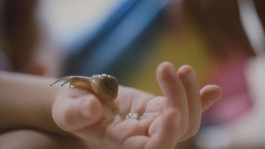
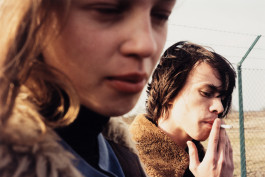
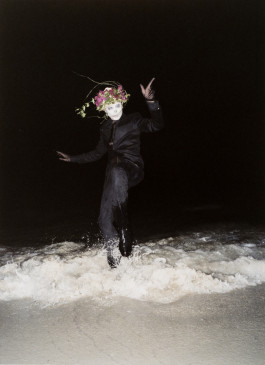
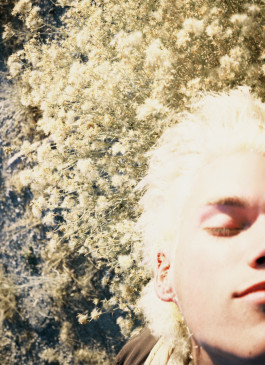
Crone Gallery is presenting Unseen, a retrospective on the work of the photographer Daniel Josefsohn. Defined by Die Zeit as the “greatest and most brilliant punk in the world of photography” his pictures are a stunning cross-section of a generation, marked by MTV imagery, hedonism, and daring stylistic features. His portraits are both intimate and bold, and their power comes from his ability to dive into the lives of the people around him without fear. His visual language was striking as both disturbing and humorous, direct and uninhibited.
The exhibition is the first one in Berlin after his death in 2016, and will present a selection of previously unpublished photographs. His legacy is as daring as the generation he portrayed and stands as an interesting reference for the artists of the future.
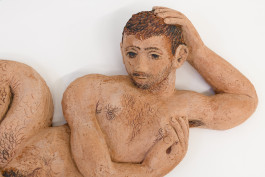
Galerie Neu is presenting some rare sculptural works by American artist Louis Fratino. His work dwells on intimate moments of queer affection, which feel like lived just a moment before being painted or sculpted. The sculptural depth adds even more intimacy if possible, making us immerse into this flow of bodies, laying hugging another body or quietly by themselves. Very interesting is the choice of the title, La Scorza (meaning: peel, skin), addressing what holds our bodies together. The title comes from a poem by Sandro Penna, which perfectly summarizes the vibe of the exhibition:
“Not only did I love the length
of hide in the romantic coverall.
But oh the tenderness overall
tucked away between peaks of strength.”
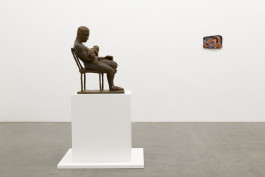
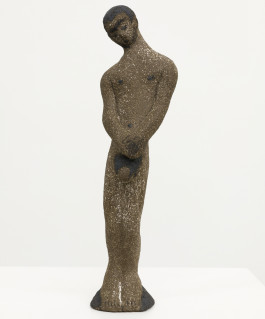
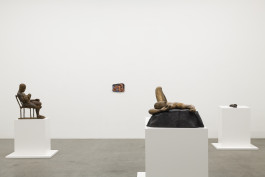
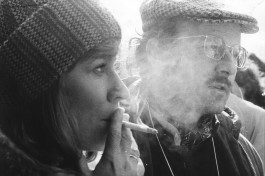
Neue Berliner Kunstverein ( n.b.k.) dedicated their current exhibition to the extraordinary work of the German movie director Margarethe von Trotta. Her practice explores history in various pivotal moments, from famous public figures to intimate histories. She was also one of the first female directors to address the role and struggles of women in society and to depict them with a realistic, unfiltered eye.
The exhibition presents all her work, from the beginning of her career as a screenwriter and actress, to the first and most recent movies as a director. The exhibition is enriched by the presence of some drafts and diaries which were never seen before. Her movies remind us of the importance of critical thinking, and challenges all the preconstructed concepts around relationships and around the difficulties of being a woman. They also investigate how different generations react to the power structures of their time, giving us a compelling insight on various historical moments of the past.
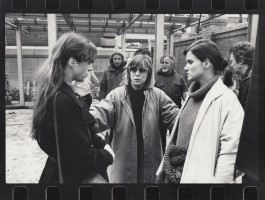
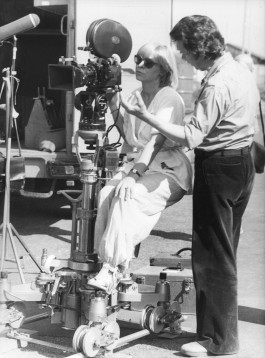
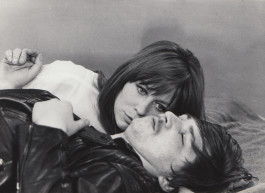
This selection of exhibitions to see after Berlin Art Week wants to make us reason on where we are and where we are going, on the issues surrounding us and on the people who are with us along the way. They are about intimacy, love, death, about the past and the future, about old traumas and new possibilities. Whether they are drawings, sculptures, movies or installations, all these works are powerful keys to understanding our humanity, in all its inconsistency and beauty. Don’t miss the chance to see these provoking exhibitions, and see where this journey takes you.
Related Articles:

The five-day festival also included performances, film screenings and talks all around the city. We also took part in it, with an evening conversation with artist Ulrike Theusner at 100 Gramm Bar & Lounge. If you didn’t have the time to see it all, there is no need to worry. Many shows are still open, and we created a selection for you of the exhibitions not to miss.
Eigen+Art opened for Berlin Art Week an exhibition with the brilliant German artist Ulrike Theusner. Her new show, titled The Passengers of the Night, lends its name from the homonymous movie, and discusses the variety of human struggles in the most poetic way. Her practice is based on drawings, and addresses it with a powerful contrast between the color she uses and the dark vibes that they convey. Her sketches are filled with obscure figures, as a way to deal with the death surrounding us and waiting for us. Yet there is a coefficient of lightness and fun, and also a suggestion for a possible way out.
The exhibition opens with the stunning drawing of a cave, as a place of comfort and solace, where we can reconnect with ourselves. In a world filled with inputs, injustices and absorbed by technology, the connection to our inner selves and to analog means seems to be fundamental. Art itself is for Theusner a way out, and a powerful instrument to deal with all the troubling things surrounding us, to find meaning, and as she said in our interview: “That's why for me it's essential to do it, because if I could not do it, it would be all inside and wouldn’t come out and I would kind of freak out.”



LAS Art Foundation inaugurated a powerful installation by Christelle Oyiri, presented for the first time in Berlin, titled Dead God Flow. The foundation always chooses different locations in the city for their exhibition, and this time it was the turn of CANK in Neukölln. The space is a former department store, iconic in its stripped past glory, and is immersed in darkness, rhythmically brightened by the neon lights of Oyiri's installation.
The artist works with various media, from music, to video and installation, and the exhibition is made up of all of them. Screened in this enthralling environment are two of her video works, Hauntology of an OG and HYPERFATE. Hauntology of an OG connects the American city of Memphis to the origin of its name in ancient Egypt, but also to the recent history of the city, which was unfortunately the place where Martin Luther King was murdered.
HYPERFATE on the other hand explores the mythologisation of rappers in American and French cultures, and analyzes the different sides of their sanctification. Her work is deeply moving, and the installation involves all our senses. As the artist stated: “Dead God flow reimagines the exhibition space as a coded séance, a choreography of image, sound and presence where the past and future refuse to separate”.




Charmaine Poh was named by Deutsche Bank artist of the year for 2025. The Singaporean- Chinese artist was thus presented for Berlin Art Week with her first institutional solo exhibition at Palais Populaire, titled Make a travel deep of your inside, and don’t forget me to take. The focus of her practice – which spans from video to installation and performance – is an investigation on identity, power structures, feminism and queerness in Southeast Asia.
The exhibition comprehends different pieces, addressing the variety of themes that are dear to the artist. As Britta Färber, the curator of the exhibition stated: “Her gentle, vulnerable, yet persistent works send a strong message against the harshness with which the exclusion of minorities and the socially disadvantaged is increasingly ignored and marginalized today”.
Her compelling work What’s softest in the world rushes and runs over what’s hardest in the world addresses the feelings of various LGBTQ+ parents, and tells their touching journeys into parenthood. Another video work, The Moon is Wet, created for the occasion of this exhibition, investigates the different facets of Singapore, from its financial role to its nature, while giving space to the forgotten stories and marginalized voices of domestic workers. Her work also addresses the traumatic experience she had as a child television star in the 1990s, and addresses the impact of early sexualization and media attention at a young age. Both delicate and powerful, her voice is an outstanding example of the insight of a generation of artists on the issues of contemporary times.




Crone Gallery is presenting Unseen, a retrospective on the work of the photographer Daniel Josefsohn. Defined by Die Zeit as the “greatest and most brilliant punk in the world of photography” his pictures are a stunning cross-section of a generation, marked by MTV imagery, hedonism, and daring stylistic features. His portraits are both intimate and bold, and their power comes from his ability to dive into the lives of the people around him without fear. His visual language was striking as both disturbing and humorous, direct and uninhibited.
The exhibition is the first one in Berlin after his death in 2016, and will present a selection of previously unpublished photographs. His legacy is as daring as the generation he portrayed and stands as an interesting reference for the artists of the future.



Galerie Neu is presenting some rare sculptural works by American artist Louis Fratino. His work dwells on intimate moments of queer affection, which feel like lived just a moment before being painted or sculpted. The sculptural depth adds even more intimacy if possible, making us immerse into this flow of bodies, laying hugging another body or quietly by themselves. Very interesting is the choice of the title, La Scorza (meaning: peel, skin), addressing what holds our bodies together. The title comes from a poem by Sandro Penna, which perfectly summarizes the vibe of the exhibition:
“Not only did I love the length
of hide in the romantic coverall.
But oh the tenderness overall
tucked away between peaks of strength.”




Neue Berliner Kunstverein ( n.b.k.) dedicated their current exhibition to the extraordinary work of the German movie director Margarethe von Trotta. Her practice explores history in various pivotal moments, from famous public figures to intimate histories. She was also one of the first female directors to address the role and struggles of women in society and to depict them with a realistic, unfiltered eye.
The exhibition presents all her work, from the beginning of her career as a screenwriter and actress, to the first and most recent movies as a director. The exhibition is enriched by the presence of some drafts and diaries which were never seen before. Her movies remind us of the importance of critical thinking, and challenges all the preconstructed concepts around relationships and around the difficulties of being a woman. They also investigate how different generations react to the power structures of their time, giving us a compelling insight on various historical moments of the past.




This selection of exhibitions to see after Berlin Art Week wants to make us reason on where we are and where we are going, on the issues surrounding us and on the people who are with us along the way. They are about intimacy, love, death, about the past and the future, about old traumas and new possibilities. Whether they are drawings, sculptures, movies or installations, all these works are powerful keys to understanding our humanity, in all its inconsistency and beauty. Don’t miss the chance to see these provoking exhibitions, and see where this journey takes you.
Related Articles:
You need to load content from reCAPTCHA to submit the form. Please note that doing so will share data with third-party providers.
More InformationYou need to load content from Turnstile to submit the form. Please note that doing so will share data with third-party providers.
More InformationYou are currently viewing a placeholder content from Facebook. To access the actual content, click the button below. Please note that doing so will share data with third-party providers.
More InformationYou are currently viewing a placeholder content from Instagram. To access the actual content, click the button below. Please note that doing so will share data with third-party providers.
More InformationYou need to load content from hCaptcha to submit the form. Please note that doing so will share data with third-party providers.
More InformationYou need to load content from reCAPTCHA to submit the form. Please note that doing so will share data with third-party providers.
More InformationYou are currently viewing a placeholder content from Turnstile. To access the actual content, click the button below. Please note that doing so will share data with third-party providers.
More InformationYou are currently viewing a placeholder content from X. To access the actual content, click the button below. Please note that doing so will share data with third-party providers.
More Information